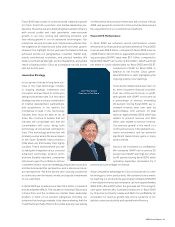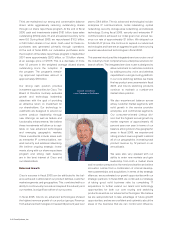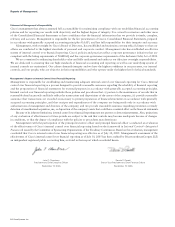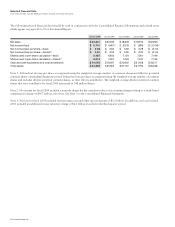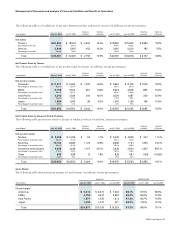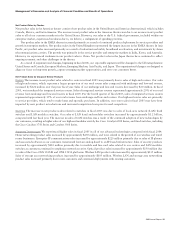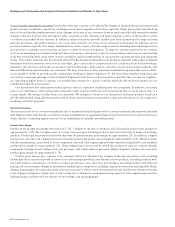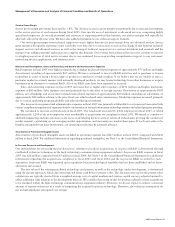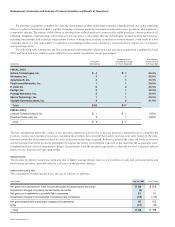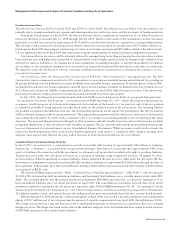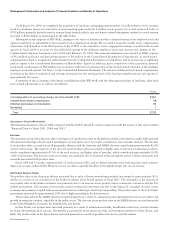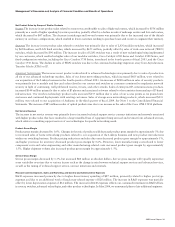Cisco 2005 Annual Report Download - page 19
Download and view the complete annual report
Please find page 19 of the 2005 Cisco annual report below. You can navigate through the pages in the report by either clicking on the pages listed below, or by using the keyword search tool below to find specific information within the annual report.
22
Goodwill Impairments
Our methodology for allocating the purchase price relating to purchase acquisitions is determined through established valuation
techniques in the high-technology communications equipment industry. Goodwill is measured as the excess of the cost of acquisition
over the sum of the amounts assigned to tangible and identifiable intangible assets acquired less liabilities assumed. We perform
goodwill impairment tests on an annual basis and between annual tests in certain circumstances for each reporting unit. The goodwill
recorded in the Consolidated Balance Sheets as of July 30, 2005 and July 31, 2004 was $5.3 billion and $4.2 billion, respectively.
In response to changes in industry and market conditions, we could be required to strategically realign our resources and consider
restructuring, disposing of, or otherwise exiting businesses, which could result in an impairment of goodwill. There was no impairment
of goodwill in fiscal 2005, 2004, and 2003.
Income Taxes
We are subject to income taxes in both the United States and numerous foreign jurisdictions. Significant judgment is required in
evaluating our tax positions and determining our provision for income taxes. During the ordinary course of business, there are many
transactions and calculations for which the ultimate tax determination is uncertain. We establish reserves for tax-related uncertainties
based on estimates of whether, and the extent to which, additional taxes and interest will be due. These reserves are established when,
despite our belief that our tax return positions are fully supportable, we believe that certain positions are likely to be challenged and
may not be sustained on review by tax authorities. We adjust these reserves in light of changing facts and circumstances, such as
the closing of a tax audit. The provision for income taxes includes the impact of reserve provisions and changes to reserves that are
considered appropriate, as well as the related net interest.
Our effective tax rates differ from the statutory rate primarily due to acquisition-related costs, research and experimentation tax
credits, state taxes, and the tax impact of foreign operations. The effective tax rate was 28.6%, 28.9%, and 28.6% for fiscal 2005,
2004, and 2003, respectively. Our future effective tax rates could be adversely affected by earnings being lower than anticipated
in countries where we have lower statutory rates and higher than anticipated in countries where we have higher statutory rates, by
changes in the valuation of our deferred tax assets or liabilities, or by changes in tax laws, regulations, accounting principles, or
interpretations thereof. In addition, we are subject to the continuous examination of our income tax returns by the Internal Revenue
Service and other tax authorities. We regularly assess the likelihood of adverse outcomes resulting from these examinations to
determine the adequacy of our provision for income taxes.
Loss Contingencies
We are subject to the possibility of various loss contingencies arising in the ordinary course of business. We consider the likelihood
of loss or impairment of an asset or the incurrence of a liability, as well as our ability to reasonably estimate the amount of loss, in
determining loss contingencies. An estimated loss contingency is accrued when it is probable that an asset has been impaired or a
liability has been incurred and the amount of loss can be reasonably estimated. We regularly evaluate current information available
to us to determine whether such accruals should be adjusted and whether new accruals are required.
Financial Data for Fiscal 2005, 2004, and 2003
Net Sales
We manage our business based on four geographic theaters: the Americas; EMEA; Asia Pacific; and Japan. Net sales, which include
product and service revenue, for each theater are summarized in the following table (in millions, except percentages):
July 30, 2005
$ 13,929
Percentage of net sales 56.2% 55.5% 55.5% 55.8%
6,866
Percentage of net sales 27.7% 27.8% 27.8% 27.6%
2,486
Percentage of net sales 10.0% 10.1% 10.1% 9.9%
1,520
Percentage of net sales 6.1% 6.6% 6.6% 6.7%
$ 24,801
Management’s Discussion and Analysis of Financial Condition and Results of Operations



